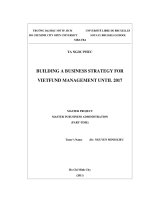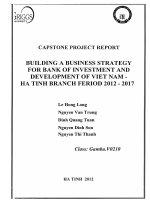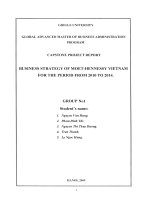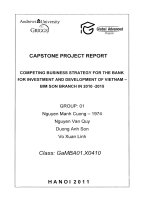Building up business strategy for Yamaha motor Vietnam by 2015
Bạn đang xem bản rút gọn của tài liệu. Xem và tải ngay bản đầy đủ của tài liệu tại đây (1.2 MB, 86 trang )
BUILDING UP BUSINESS STRATEGY FOR
YAMAHA MOTOR VIETNAM BY 2015
Hoang Ha
Nguyen Ke Phu
Le The Son
Dang Thi Nhan
Class: GaMBA.X0409
H A N O I 2 0 1 1
CAPSTONE PROJECT REPORT
HA NOI 2011
GRIGGS UNIVERSITY
GLOBAL ADVANCED MASTER OF BUSINESS ADMINISTRATION PROGRAM
CAPSTONE PROJECT REPORT
BUILDING UP BUSINESS STRATEGY
FOR YAMAHA MOTOR VIETNAM BY 2015
Hoang Ha
Nguyen Ke Phu
Le The Son
Dang Thi Nhan
Group Number: 03
Student’s name:
DECLARATION
We hereby certify that this capstone project report represents the result of our
own research. No other person’s previously published or written work has been used
without due acknowledgement in the text.
No material has been used in this report which has been accepted for the award
of a degree or diploma in any tertiary institution.
Group 3 – Class: GaMBA.X0409
TABLE OF CONTENTS
DECLARATION i
LIST OF ABBREVIATIONS vi
LIST OF TABLES vii
LIST OF FIGURES viii
INTRODUCTION 1
CHAPTER 1 : THEORETICAL BACKGROUND ON BUILDING BUSINESS
STRATEGY 2
1.1.
Definition and classification of Business strategy 2
1.1.1.
Definition of Business strategy 2
1.1.2.
Roles of Business Strategy 3
1.1.3.
Classification of Business Strategy 4
Corporate level Strategy 4
Strategic Business Unit level (SBU) 4
Functional level strategy 4
1.2.
Process of generating and selecting strategies 5
1.2.1.
The Input Stage 6
1.2.1.1.
External Factor Evaluation Matrix (EFE Matrix) 6
1.2.1.2.
The Internal Factor Evaluation Matrix (IFE Matrix) 7
1.2.2.
The Matching Stage 8
1.2.2.1.
The Strengths – Weaknesses – Opportunities – Threats Matrix
(SWOT Matrix) 8
1.2.2.2.
The Boston Consulting Group Matrix (BCG Matrix) 9
1.2.2.3.
The Internal – External Matrix (IE Matrix) 10
1.2.3.
The Decision Stage - The Quantitative Stategic Planning Matrix
(QSPM Matrix) 11
CHAPTER 2 : BUILDING UP THE BUSINESS STRATEGY FOR YAMAHA
MOTOR VIETNAM BY 2015 12
2.1.
General information about Vietnam motorcycle market 12
2.1.1.
Southeast Asian motorcycle market 12
2.1.2.
Vietnam motorcycle market 14
2.1.2.1.
Current situation of Vietnam motorcycle market 14
2.1.2.1.
Master plan for the development of Vietnam’s motorcycle industry
by 2015, with a vision to 2020 16
2.2.
General introduction about Yamaha Motor Vietnam Co., Ltd 18
2.2.1.
The process of establishment and organization structure 18
2.2.1.1.
The process of establishment 18
2.2.1.2.
Organization Structure 19
2.2.2.
Situation and Business performance from 2006 to 2010 20
2.3.
Building up the business strategy for YMVN by 2015 21
2.3.1.
Analyzing factors affecting the business strategy of YMVN 21
2.3.1.1.
External factor evaluation matrix (EFE) 21
GENERAL ENVIRONMENT 21
INDUSTRIAL COMPETITION 26
2.3.1.2.
Internal factor evaluation matrix (IFE) 34
FINANCE 34
PERSONNEL ORGANIZATION 36
RESEARCHING AND DEVELOPING ACTIVITIES (R&D) 37
BRAND NAME 39
THE MARKETING MIX STRATEGY 40
2.3.2.
Constructing matrix to perform feasible strategies 49
2.3.2.1.
The Strengths – Weaknesses – Opportunities – Threats Matrix
(SWOT Matrix) 49
2.3.2.2.
The Boston Consulting Group (BCG) Matrix 51
2.3.2.3.
The Internal-External (IE) Matrix 51
2.3.3.
Strategy analysis and formualation 56
2.3.3.1.
The Quantitative Strategic Planning Matrix (QSPM) 56
2.3.2.2.
Business Strategy Analysis 61
CHAPTER 3 : SOME SOLUTIONS TO IMPLEMENT THE BUSINESS
STRATEGY OF YMVN BY 2015 64
3.1.
Some solutions to implement the business strategy of YMVN by 2015 64
3.1.1.
Solutions to implement the Focus and Growth Strategy for Sporty
Scooter Market 64
3.1.2.
Some solutions to implement the Cost Leadership strategy to increase
the penetration in basic moped market 65
3.1.3.
Solutions on functional strategy 66
3.1.3.1.
Solutions on marketing management 66
3.1.3.2.
Solutions on R&D activities 67
3.1.3.1.
Solutions on human resources management 69
3.1.4.
Budget for business strategy by 2015 70
3.2.
Some recommendations to the state 71
CONCLUSION 73
REFERENCES 75
LIST OF ABBREVIATIONS
ASEAN
The Association of Southeast Asian Nations
BCG
Boston Consulting Group
DO
Direct Operation Shop
EFE
External Factor Evaluation
FDI
Foreign Direct Investment
GDP
Gross Domestic Product
HVN
Honda Viet Nam Company
IE
Internal – External Matrix
IFE
Internal Factor Evaluation
QSPM
Quantitative Strategic Planning Matrix
R&D
Research & Development
ROA
Return On Assets
ROE
Return On Equity
SBU
Strategic Business Unit
SSC
Super Service Campaign
SWOT
Strengths-Weaknesses-Opportunities-Threats
VMTC
Vietnam Register Motor Vehicle Testing Center
WTO
World Trade Organization
YFS
Yamaha Factory Service
YMVN
Yamaha Motor Vietnam Co., Ltd.
LIST OF TABLES
Table 1.1: SWOT Matrix 8
Table 2.1: YMVN product categories 18
Table 2.2: Business performance from 2006 to 2010 (Unit: Thousand USD) 21
Table 2.3: Comparison of motorcycle manufacturers in Vietnam 27
Table 2.4: EFE Matrix for YMVN 33
Table 2.5: Financial data of YMVN and HVN 34
Table 2.6: Employment status of YMVN 36
Table 2.7: YMVN and HVN product strategy comparison 40
Table 2.8: The distribution system characteristics of YMVN and HVN 44
Table 2.9: Advertising strategy comparison between YMVN and HVN 47
Table 2.10: IFE matrix for YMVN 48
Table 2.11: SWOT Matrix for YMVN 49
Table 2.12: Relative market share position and Industry sales growth rate 51
Table 2.13: IFE Score for Each Strategic Category 52
Table 2.14: EFE Score for Each Strategic Category 53
Table 2.15: The IFE ad EFE Total weighted score for YMVN 54
Table 2.16: QSPM for YMVN 56
Table 3.1: Budget allocation for total YMVN strategic plan by 2015 70
LIST OF FIGURES
Figure 1.1: The Strategy-Formulation Alnalytical Framework 6
Figure 1.2: BCG Matrix 9
Figure 1.3: The IE Matrix 10
Figure 2.1: Market share of motorcycle makers in main ASEAN markets 13
Figure 2.2: Yamaha Motor unit sales by country in main ASEAN markets 13
Figure 2.3: Demand for motorcycles in Vietnam from 1995-2010 15
Figure 2.4: Motorcycles demand in Vietnam 2006-2010, with a prediction to 2015 16
Figure 2.5: YMVN Organization Structure 19
Figure 2.6: The sales results and market share of YMVN period 2006-2010 20
Figure 2.7: The five-forces model of competition 26
Figure 2.8: Customers’ evaluation about YMVN and HVN brand name 40
Figure 2.9: The diagram of pricing competitive products 42
Figure 2.10: YMVN and HVN distribution channels comparison 44
Figure 2.12: The IE Matrix for YMVN 55
Figure 2.13: The demand trend for over 20 million VND motorcycle 59
Figure 2.14: Basic Moped Motorcycle Demand Trend 60
GaMBA.X0409 – Group 3
INTRODUCTION
1. General context, the necessity and implication of the research project
Vietnam’s motorcycle assembly and manufacturing industry, formed since
1990, initially based on the investment of Japanese and Taiwanese motorcycle makers,
has rapidly developed and sufficiently met the domestic demand for basic motorcycles.
The positive development of the motorcycle industry has come from the great demand
for motorcycles in Vietnamese market and the policies to encourage foreign investment
by government.
Yamaha Motor Vietnam, one of the FDI manufacturers has gained a relatively
strong position in the motorcycle market in Vietnam. Although it was a latecomer,
Yamaha has worked to build products which stand among the very best in the country
through its constant pursuit of quality; and at the same time, through these products, it
has sought to contribute to the quality of life of people nationwide.
Following on the success, Yamaha has set up their target to become the number
one brand name in manufacturing motorcycles for the youth. In order to achieve this
goal, the company should engage in strategic planning to make effective decisions.
Based on the need for intergrating analysis and intuition in strategic management, our
group has decided to formulate some strategies for Yamaha in the capstone project
report: “Building up business strategy for Yamaha Motor Vietnam by 2015”.
2. Objectives of the study
The study objectives include:
• To explain the concept, role and process of formulating a business
strategy
• To conduct business strategies for Yamaha by 2015
• To give some recommendations and measures to implement strategies.
GaMBA.X0409 – Group 3
3. Scope of the study
The study focuses on Yamaha business status in Vietnam motorcycle market
from 2006 to 2010, and then proposes some business strategies by 2015.
4. Methodology
Many different methods are utilized in this study in order to have a wider
understanding of Yamaha business status and to gain an overall picture between
Yamaha and its competitors within Vietnam motorcycle market. These include: desk
research, internet research, comparison, analysis, statistic, summary…
5. Structure of the study
Besides the introduction and conclusion, the capstone project report involves
three chapters:
Chapter 1: Theoretical background on Business strategy management
Chapter 2: Building up business strategy for Yamaha Motor Vietnam by 2015
Chapter 3: Some solutions to implement business strategy for Yamaha Motor
Vietnam by 2015.
In the process of researching, there may be some limitations; thus we would be
very grateful to get your comments and feedbacks. Thank you very much!
Group 3 – Class: GaMBA.X0409
CHAPTER 1 : THEORETICAL BACKGROUND ON BUILDING
BUSINESS STRATEGY
1.1. Definition and classification of Business strategy
1.1.1. Definition of Business strategy
The term “Strategy” derives from the military field with the meaning to indicate
the large and long-term plan on the basis sure what the enemy can and can not do.
GaMBA.X0409 – Group 3
Since then the term “Business strategy” was born. According to the traditional
viewpoint, "Strategy is the direction and scale of an organization in long-term, which
will bring advantages to the organizations through the optimum arrangement of
resources in a competitive environment to meet market demands and expectations of
stakeholders."
According to Alfred Chandler: “Strategy includes the basic long-term goals of
an organization, and the selection of the way or process to act, the allocation of
necessary resources to implement to achieve these goals."
According to William J'. Glueck: "Strategy is a consistent, comprehensive and
coordinated plan which is designed to ensure that the basic objectives of the
organization will be done."
According to Fred R. David: "Strategy is the means to achieve long-term goals.
Business strategy may include the development of geography, diversification of
activities, property, product development, market penetration, expenditure cuts,
liquidation, and joint ventures."
According to Michael E. Porter: "Strategy is the art of building a solid
competitive advantage to defense."
1.1.2. Roles of Business Strategy
The business strategy management will help the organization:
• Find their objectives and direction to choose their own ways to achieve
the goals and to know the location of businesses in the process of
implementing these goals.
• Identify opportunities and threatens from external environment, the
internal strengths and weaknesses; then to promote the strengths,
minimize weaknesses, catch opportunities and prevent risks from outside.
GaMBA.X0409 – Group 3
• Make business decisions in line with the business environment in order to
improve efficiency and productivity.
• Choose the appropriate competitive advantages in the changing business
environment, and find out how to survive and grow to enhance the
competitive position of the enterprise.
1.1.3. Classification of Business Strategy
Corporate level Strategy
Corporate level strategy identifies the orientation of the organization in the long
term, to complete tasks and achieve the growth target. On the basis of corporate level
strategy, the organization will develop its own strategies.
Strategic Business Unit level (SBU)
Strategic Business Unit (SBU) in a company can be a strategy for a segment or a
product category, etc. This strategy is aimed at the development orientation of each
sector or individual product categories for making optimal contribution to the
achievement of corporate-level objectives. The company must clearly identify the
advantages of each sector compared to the competitors to make the strategy consistent
with corporate level strategy.
Functional level strategy
Each company has many functional departments such as marketing, human
resources, finance, manufacturing, research and development, etc. The departments
should have their specific functional level strategies to support the implementation of
strategic business unit and corporate level strategies.
In conclusion, the three basic levels strategies are not independent but have such
a closely connection that the strategic level is a precondition for lower-level strategies,
while lower-level strategies should adapt to the higher-level strategies so that the new
strategy implementation can be sucessful and effective.
GaMBA.X0409 – Group 3
1.2. Process of generating and selecting strategies
According to Fred R. David, importance strategy-formulation techniques can be
integrated into a three-stage decision-making framework, as shown in Error!
Reference source not found The tools presented in this framework are applicable to
all sizes and types of organizations and can help strategists identify, evaluate and select
strategies.
Stage 1 – The Input Stage: consists of the EFE matrix, IFE matrix, and the
Competitive Profile Matrix (CPM).
Stage 2 – The matching stage: Stage 2 techniques include the SWOT
matrix, BCG matrix, IE matrix, and the Grand strategy matrix.
Stage 3 – The decision stage: involves a single technique, the Quantitative
strategic planning matrix (QSPM).
With a limited scale of the capstone project report, we hereby just base on some
keys tools to analyze Yamaha business performance such as: EFE matrix, IFE matrix,
SWOT matrix, BCG matrix, IE matrix and QSPM. The followings will examine the
concepts and basic knowledge of tools needed to conduct a strategic audit for Yamaha.
GaMBA.X0409 – Group 3
Source: Fred R. David, Strategic Management Concepts and Cases, Figure 6-2, P.222
Figure 1.1: The Strategy-Formulation Alnalytical Framework
1.2.1. The Input Stage
1.2.1.1. External Factor Evaluation Matrix (EFE Matrix)
An EFE matrix allows strategists to summarize and evaluate economic, social,
cultural, demographic, environmental, political, governmental, legal, technological,
and competitive information. The EFE matrix can be developed in five steps:
• Step 1: List 10 to 20 key external factors, including both opportunities
and threats.
• Step 2: Assign to each factor a weight that ranges from 0.0 (not
important) to 1.0 (very important). The sum of all weights must equal
1.0.
The input stage
External Factor
Evaluation Matrix
(EFE)
Competitive
Profile Matrix
Internal Factor Evaluation
Matrix (I
FE)
The matching stage
Strengths-
Weaknesses-
Opportunities-Threats
Boston Consulting Group
Matrix (BCG)
External – Internal
Matrix (IE)
Grand Strategy
Matrix
The decision stage
Quantitative Strategic Planning Matrix (QSPM)
GaMBA.X0409 – Group 3
• Step 3: Assign a rating between 1 to 4 to each key external factor to
indicate how effectively the firm’s current strategies respond to the factor
(4= the response is superior)
• Step 4: Multiply each factor’s weight by its rating to determine a
weighted score.
• Step 5: Sum the weighted scores for each variable to determine the total
weighted score for the organization.
Regardless of the number of key opportunities and threats included in an EFE
matrix, the highest possible total weighted score for an organization is 4.0 and the
lowest possible total weighted score is 1.0.
1.2.1.2. The Internal Factor Evaluation Matrix (IFE Matrix)
The IFE matrix summarizes and evaluates the major strengths and weaknesses
in the functional areas of a business, and it also provides a basis for identifying and
evaluating relationships among those areas. An IFE matrix can be developed in five
steps:
• Step 1: List 10 to 20 key internal factors, including both strengths and
weakenesses.
• Step 2: Assign weight that ranges from 0.0 (not important) to 1.0 (all-
important) to each factor. The sum of all weights must equal 1.0.
• Step 3: Assign a 1-to-4 rating to each factor to indicate whether that
factor represents a major weakness (rating= 1), a minor weakness
(rating= 2), a minor strength (rating= 3), or a major strength (rating= 4).
• Step 4: Multiply each factor’s weight by its rating to determine a
weighted score for the organization.
• Step 5: Sum the weighted scores for each vaiable to determine a
weighted score for the organization.
GaMBA.X0409 – Group 3
Regardless of how many factors are included in an IFE matrix, the total
weighted score can range from a low of 1.0 to a high of 4.0, with the average score
being 2.5. Total weighted scores well below 2.5 characterize organizations that are
weak internally, whereas scores above 2.5 indicate a strong internal position.
1.2.2. The Matching Stage
1.2.2.1. The Strengths – Weaknesses – Opportunities – Threats Matrix
(SWOT Matrix)
SWOT matrix is used to list all the opportunities, threats, strengths and
weaknesses within the business by appropriate order and position. Based on the
relationship between these factors, the analysis will select suitable solutions through
strategic combinations:
• S-O (Strengths-Opportunities): Use a firm’s internal strengths to take
advantage of external opportunities.
• S-T (Strengths-Threats): Use a firm’s strengths to avoid or reduce the
impact of external threats.
• W-O (Weaknesses-Opportunities): Aim at improving internal
weaknesses by taking advantage of external opportunities.
• W-T (Weaknesses-Threats): Aim at reducing the internal weakness to
avoid external threats
Table 1.1: SWOT Matrix
SWOT Matrix
Oppotunities ( O)
Listed in the order of
importance
Threatens ( T)
Listed in the order of
importance
Strengths ( S)
Listed in the order of
importance
SO Strategies
Use strengths to exploit
opportunities
ST Strategies
Use strengths to avoid
threatens
GaMBA.X0409 – Group 3
Weaknesses ( W)
Listed in the order of
importance
WO Strategies
Limit weaknesses to exploit
opportunities
WT Strategies
Minimize risks and avoid
threatens
1.2.2.2. The Boston Consulting Group Matrix (BCG Matrix)
The BCG Matrix allows a multidivisional organization to manage its portfolio
of businesses by examining the relative market share position and the industry growth
rate of each division relative to all other divisions in the organization.
Source: Fred R. David, Strategic Management Concepts and Cases, Figure 6-6, P.232
Figure 1.2: BCG Matrix
• Question Marks: The organization must decide whether to raise market
share by improving product, service or invest more to enhance
competitiveness.
High +20
Low -20
Medium
10
Relative Market Share Position
II
Star
I
Question marks
IV
Dogs
III
Cash cows
Industry
Sales
Growth
Rate
High 1,0
Medium 0,5
Low 0,0
GaMBA.X0409 – Group 3
• Stars: Forward, backward, and horizontal integration; market
penetration; market development; and product development are
appropriate strategies fir these divisions to consider.
• Cash Cows: Product development or diversification may be attractive
strategies for strong Cash Cows. However, as Cash Cows division
becomes weak, retrenchment or divestirure can become more
appropriate.
• Dogs: Cost reduction can become the most appropriate strategy.
1.2.2.3. The Internal – External Matrix (IE Matrix)
The IE Matrix positions an organizations’ various divisions in a nine-cell
display, illustrated in Figure 1.3. Each division of an organization should construct an
IFE matrix and an EFE matrix, based on that, IE matrix is built up.
Source: Fred R. David, Strategic Management Concepts and Cases, Figure 6-9, P.234
Figure 1.3: The IE Matrix
I
II
III
IV
V
VI
VII
VIII
IX
Strong
3,0 to 4,0
The IFE total weighted scores
Average
2,0 to 2,99
Weak
1,0 to 1,99
The EFE
total
weighted
scores
High
3,0 to 4,0
Medium
2,0 to 2,99
Low
1,0 to 1,99
Grow and build
Hold and maintain
Harvest or divest
GaMBA.X0409 – Group 3
1.2.3. The Decision Stage - The Quantitative Stategic Planning Matrix
(QSPM Matrix)
The Quantitative Stategic Planning Matrix (QSPM) uses input from Stage 1
analyses and matching results from Stage 2 analyses to decide objectively among
alternative strategies. This matrix is developed in 06 steps:
• Step 1: Make a list of the firm’s key external opportunities/threats and
internal strengths/weaknesses in the left column of the QSPM.
• Step 2: Assign weights to each key external and internal factors.
• Step 3: Identify alternative strategies that the organization should
consider implementing.
• Step 4: Determine the Attractiveness Scores (AS) defined as numerical
values that indicate the relative attractiveness of each strategy in a given
set of alternatives (range for AS from 1 to 4).
• Step 5: Compute the Total Attractiveness Scores (TAS). TAS are defined
as the product of multiplying the weights (Step 2) by the AS (Step 4) in
each row.
• Step 6: Compute the Sum Total Attractiveness Scores (STAS). Add TAS
in each strategy colume of the QSPM. The STAS reveal which strategy is
most attractive in each set of alternatives.
GaMBA.X0409 – Group 3
CHAPTER 2 :
BUILDING UP THE BUSINESS STRATEGY FOR
YAMAHA MOTOR VIETNAM BY 2015
2.1. General information about Vietnam motorcycle market
2.1.1. Southeast Asian motorcycle market
Asia is the region that produces the most motorcycles in the world and also the
biggest consumption market, accounting for more than 80% of total registered units in
worldwide. Currently the leading motorcycle manufacturing country is China, holding
nearly 50% of total Asian outputs, about over 17 million units per year. Some other
countries also having quite high output are Indonesia, India with over 5 million units
per year.
Particularly in Southeast Asian area, five countries with the highest motorcycles
yields are: Indonesia, Vietnam, Thailand, Philippines and Malaysia, accounting for
nearly 30% of total Asian production. In these five ASEAN countries, the motorcycle
market has continuously developed in both quantity and quality. Overall motorcycle
demand in 2010 in this region grew 21% from the previous year, to 13.5 million units.
Honda is still the manufacturer occupying the largest market share. Especially, in
Thailand, Honda takes the dominant position when its market share reaches 72%; this
figure in Vietnam is 54%. Despite of that, Yamaha Motor Corporation (YMC) views
these markets as important and strategic regions in Asia; thus in recent years, YMC has
bolstered its lineup with the introduction of new products and carried out proactive
sales activities in each market. This results in the considerable growth rate in the
Yamaha market share. Currently, the largest market in ASEAN is Indonesia where the
market share of Yamaha reaches 46%.
GaMBA.X0409 – Group 3
Resource: Yamaha Motor Corporation - Annual Report 2010
Figure 2.1: Market share of motorcycle makers in main ASEAN markets
In 2010, Yamaha unit sales in these five major markets grew 26%, to 5,023,000
units, far outpacing the increasing in overall demand (21%).
Resource: Yamaha Motor Corporation - Annual Report 2010
Figure 2.2: Yamaha Motor unit sales by country in main ASEAN markets
GaMBA.X0409 – Group 3
With the aim to raise the target of increasing the unit sales in the ASEAN to
roughly 6 million units by fiscal 2012, YMC has strived to research and organize
manufacturing structure and now have completed production capacity of 3,6 million
units in Indonesia and 1,0 million units in Vietnam. YMC has also begun to further
increase their production capacity in Indonesia, to establish a structure that will be able
to produce 4,0 million units in fiscal 2012. It can be said that in the time to come,
South East Asia will still be the region having a great growth rate and a remarkable
motorcycle demand globally.
2.1.2. Vietnam motorcycle market
2.1.2.1. Current situation of Vietnam motorcycle market
Together with the achievement in the renovation of the country, the life of
people is improved clearly, the demand for travelling is also paid attention to; therefore
many means of traffic have been researched, produced and put into use. In Vietnam
two decades ago, motorcycles were just the minority, being considered as an asset
rather than means of commuting; however, motorcycles are now more and more
popular and become the majority means of transportation across the country,
accounting for about 61% total vehicles.
From 1995-1999, FDI motorcycle manufacturers have initially invested in
assembly, on the basis of importing the components from oversea and then gradually
increased the localization ratio to produce motorcycles localizationly. In the period
from 2000 to 2003, many local enterprises involving in trading, assembling
motorcycles with components originated from China had mushroomed nationwide.
In 2003, the Chinese motorcycle products accounted for 65-70% of the domestic
market. The low quality products at low sales prices could meet the demands of
majority people with low incomes, thus it quickly dominated the consumption market.
However, from 2005, FDI enterprises adjusted their business strategies by changing
new models, reducing production costs, concentrating on the basic moped motorcycles
GaMBA.X0409 – Group 3
to increase their market share. As the result, the sales of Chinese motorcycle were
dropped remarkably and instead of that were the product of prestigious joint-venture
companies such as: Honda, YMVN, Suzuki, SYM, Piaggio…
Unit: Thousand units
Source: Statistic data of YMVN
Figure 2.3: Demand for motorcycles in Vietnam from 1995-2010
Currently, Vietnam has become the fourth largest motorcycle market in the
world, only after China, India and Indonesia. The domestic demand is more varied. In
the period from 1996 to 2002, the major demand was basic moped motorcycles whose
engine capacity was from 50cc to 100cc, but from 2003 to 2008 the demand for
motorcycles was more diversified and there was the appearance of scooter models.
Since only accounting about 8% market share in 2006, the demand for scooters has
been increasing rapidly and attained about 30% total domestic demand for motorcycles
by later 2010. However, the basic moped motorcycle demand is still an attractive piece
of cake that enterprises should not ignore.









